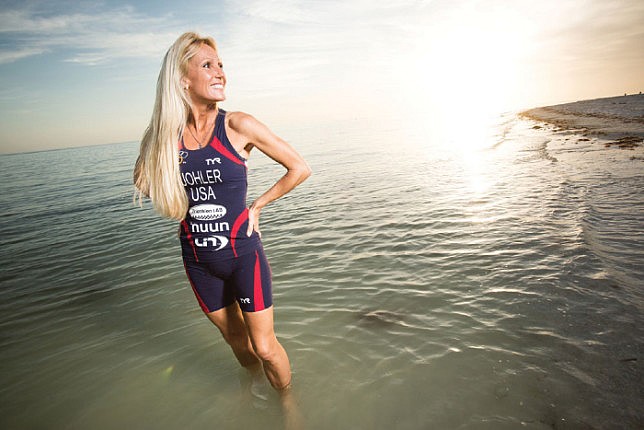A terrifying bike accident left endurance duathlete Lisa Buohler clinging to life in a hospital bed—but not for long.
After the bike accident that fractured her spine in five places, Lisa Buohler had only one question: How did this happen to me?
The question wasn’t philosophical; Buohler simply didn’t know. She remembered going out for her ride, spinning out into the warm sunshine on her new Trek Speed Concept 9.9. Then, she remembered a giddy moment just after the collision when she touched her hand to her shredded bike shorts and felt a jolt of panic. With the extent of her injuries not yet known, her first fear was to wonder how she would find another pair of shorts in time to compete at the ITU World Duathlon Championships in Spain, just two days away.
But the actual accident, the moment on Sept. 14, 2011, when an SUV struck her from behind and threw Buohler more than 20 feet down a stretch of pavement, was lost. Eventually, Buohler allowed herself to surrender the memory, accepting that it was her body’s way of protecting itself from something perhaps too painful to bear.
It’s just one of the many mental shifts Buohler has made since the accident, one of the ways she now grants herself a little more latitude than before she was injured. The word she most often uses to describe her pre-accident training attitude is “obsessive.”
“Gosh,” she says with a laugh, “I’ve learned so much about patience.”
Throughout the healing process, she pushed herself to improve, occasionally ignoring medical advice in favor of what she sensed was right for her own recovery. At the same time, she found herself confronting the fact that her body—once her strongest and most reliable ally—was often unwilling to cooperate. Reconciling her goals with reality meant achieving a level of acceptance that was previously unfamiliar to the endurance athlete.
“Coming back, it was so mental,” Buohler explains. “I was constantly fighting with myself because I had doctors here saying, ‘no, no, no,’ and then I’m thinking, ‘a little bit, a little bit. I’ve got to do this, I’ve got to do this. I’ve got to make some changes. I’m not just the average. But do I know my body?’”
In time, “how did this happen?” was replaced by another question: “When will I compete again?”
The answer was sooner than anyone expected.
A time to cry
Originally from England, the 43-year-old Buohler began running and biking competitively in 2006. She ran her first marathon, the Athens Classic 2500th anniversary in Greece, in October 2010, and qualified for the Boston and New York marathons. Now a personal trainer and running coach, Buohler has several sponsors, including Triathlon Lab and Livewire Energy.
Prior to the accident, she was preparing to leave for the ITU World Duathlon Championships. After the accident, her back was broken in five places. Her sternum, patella and pelvis were also fractured, her liver was lacerated, and the muscles in her left buttock and calf muscle were severely damaged. Additionally, she had a tear in the muscle of her shoulder and a lung contusion. As her days in the ICU stretched into six, the list of injuries seemed to lengthen, Buohler recalls.
Fitted with a brace to support her back, she was released to a friend who could care for her until Buohler was stronger and able to return to her own home and family. Out of the hospital, Buohler began to realize how foreign her world had become. All her life, she had been active, embracing everything from judo to horseback riding. And when it came to competition, Buohler was passionate about achieving her personal best, completing a 5K in a brisk 17:27 and a sprint duathlon in just 49:22.
Now she was reliant on her friend to eat, help her to the bathroom, even to roll over in bed. It was terrifying, she recalls.
“I realized how un-independent I was, how I couldn’t do anything for myself,” Buohler says.
Someone else might have spared themselves any details of the ITU World Duathlon Championships, but Buohler sought it out. The morning of the race, she lay in bed and went online to view the results. Many of her friends competed in the event, and Buohler pored over their status updates on Facebook. She thought about how hard she had trained and how much she hoped to earn a spot on the podium.
After everything, it was all too much.
“I just started to sob,” she says. “That was the first time I cried since my accident. That was the first time everything hit me, that I was so useless.”
First walk, then run
After her friend’s care, Buohler returned to her own home in Lee County. There, all her thoughts turned to recovery and to when she might be able to ride and run again. But even simple tasks defeated her: The brace limited her mobility and made everyday tasks such as brushing her teeth impossible, and as she tried to regain her independence, Buohler discovered new aches and pains from her injuries.
Four weeks after the accident, she decided she was going to go for a short walk in her neighborhood. She was still in the brace—she wore it for 12 weeks total—but she felt she had to get out of her house. She started slowly building her time, persevering through the stiffness and throbs of pain, until she was walking up to an hour and a half daily.
On her walks, she often daydreamed about the Walt Disney World Half Marathon in January 2012, which she had intended to do prior to the accident. Already, Buohler was making her plans to return to racing.
Not that she shared those plans with anyone. When she asked her doctor about running, he told her she wasn’t ready yet. When she persisted, he scolded her for being selfish and reminded her she could easily be in a wheelchair or worse. His words gave her pause, especially since they touched a tender spot. Buohler admits she often felt guilty after the accident, especially because she couldn’t care for her family in the same way as before.
“I really thought then, am I being selfish? It humbled me a little bit. I do appreciate that I’m still here, and I do appreciate that I’m not in a wheelchair,” she says. “But I’m not stopping there.”
She began to add a few more activities to her routine, such as a recumbent bike and resistance bands. She read voraciously, trying to learn as much as she could about the right kind of physical therapy for her injuries. Everything was trial-and-error, she says—if she didn’t see a benefit right away, she switched to something else.
Through it all, she kept her efforts private, knowing that she might be told to take it slower than she was ready to go. She especially rebelled at the thought that her doctors expected her recovery to be similar to someone who was not a world-class athlete. If there was one thing Buohler didn’t want to be called, it was ordinary.
“It depressed me,” she says. “I’m not going to be judged like the average person.”
That’s advice she gives to other recovering athletes too, not just those in endurance training.
“Never give up and think that you should have all these limits because of something,” she says. “You might find that some things that people told you were limits at the start, they’re not really limitations.”
It was a difficult time for Buohler. In competition, she could share her successes. Now in recovery, the power of her independent perseverance shone as she struggled alone by choice.
“That was really tough,” she says. “It was very confusing. And that was why the walks were very important.”
But on New Year’s Day 2012, Buohler was tired of walking. Relieved of her brace and feeling stronger, she gathered a few of her closest running friends together and decided to try for one mile. At first, she was frightened, wondering how her back and spine would feel. Choosing to trust in the therapy she had done, she began to run. Her body felt odd and everything ached, but there was no sharp pain. She continued to run, powering through to the one-mile mark in 7:15.
“The fact that I had completed that mile just gave me inner strength,” Buohler says.
The Disney Half Marathon was just one week away. If she could run one mile, Buohler reasoned, she could walk 13.
Boston and beyond
When Buohler lined up for the Disney Half Marathon, she was in the elite start at the front of the pack. Also at the start were several disabled athletes competing in wheelchairs. Standing in the dark, Buohler began to think about the accident and how it could have gone differently. She quickly shoved those thoughts aside.
“But no, I’m here,” she recalls saying to herself. “I’m standing here, and I was able to run a mile a week ago.”
She started out at an easy jog, allowing many of the runners to pass her by. At the two-mile mark, she was still running but began to experience some sharp pain. Rather than try to push through it, she decided she was done. At her spot on the course, she couldn’t find a medic. So after a short break, she slowly continued to run, walking and running her way to the finish without any more pain.
After the Disney Half Marathon, Buohler began looking ahead to another race: the legendary Boston Marathon. One week before the April event, her doctor had given her permission to run again, and three days before the race, Buohler managed to run six miles without stopping. Encouraged, she decided to do the race, but when she and her husband, Sebastian, arrived in Boston, they were met with record temperatures. Thousands of racers were deferring to the next year rather than face the heat, and the race time had been extended to six hours to give runners extra time to finish.
Buohler didn’t want to defer. She reasoned that she might never get another chance to be there, and she just wanted to be a part of it. She decided to run, and went on to complete the race in 3:48—two minutes shy of qualifying again.
“I didn’t even know what my time was at the finish because I just came through and was thinking, I’m here and I’m at the finish line. I just ran the Boston Marathon six months after my accident,” she says.
Running the race gave her a sense of accomplishment, but Buohler is quick to add that it didn’t mean she was back to her old self.
In truth, that day still hasn’t arrived. Almost a year and a half after her accident, her biking and running times are strong, but her duathlon transition times are the worst she’s ever experienced. Because of the spine injury, the endurance athlete’s mobility and flexibility were issues in a way that they never were before, Buohler explained.
“I don’t feel normal, still,” she says. “I can really feel and tell my injuries sometimes. But I’m doing amazing. I feel good. I’m able to keep up with my fitness, and I’m able to do what I like to do.”
For now, that’s enough. She still wants to be the best, but also she wants to enjoy it.
“I definitely feel that I should try to have a little more fun and not be so obsessive about my training,” she says. “I don’t feel like I have to go out and run that race. It’s OK now. I realize that the time goes by, and it’s no big deal.”

